Being the captain of your own ship has never been the easiest way to make a living, but since the COVID-19 pandemic forced temporary business closures and shook up the global supply chain, the ongoing effects on the economy have made things difficult for small-business owners in a multitude of new ways.
The kinds of businesses that were once the lifeblood of the U.S. economy have been forced to deal with rising material costs, product shortages, and a very challenging labor market. These challenges have impacted small-business owners in different ways depending on whether they adopted a remote, on-site, or hybrid work model during the pandemic. In this study, we surveyed over 500 small-business owners and asked them about the challenges they are facing in the current economic climate. Read on to find out what we discovered.
Challenges Affecting the Backbone of the Economy
Chances are if you've spent time in restaurants, retail spaces, or grocery stores in the last two years, you've noticed things aren't quite the same as they once were. Maybe it's fewer products, higher prices, or one less employee behind the counter causing delays to your order, but all kinds of businesses have experienced marked changes in day-to-day operations.
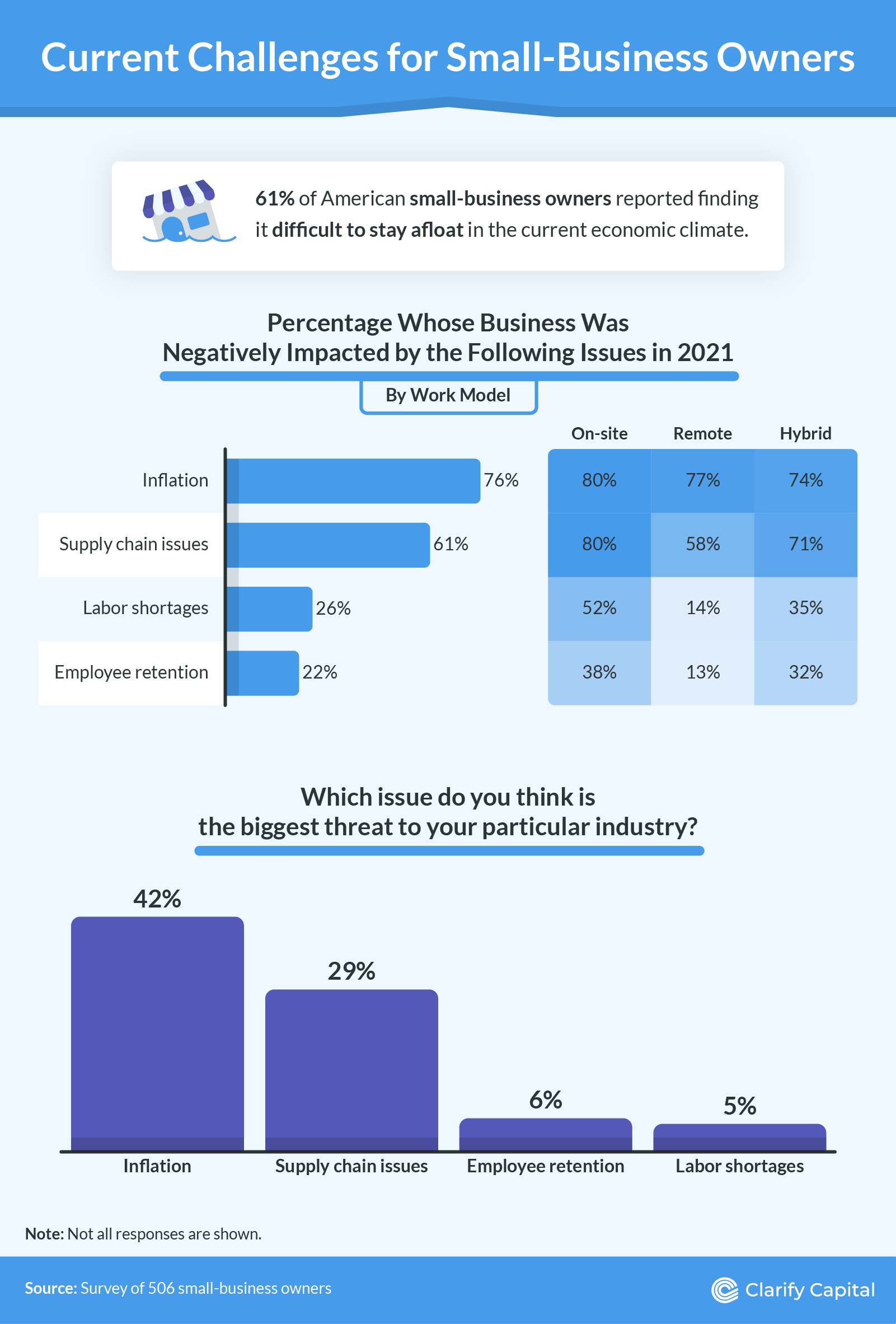
Some of the hardest hit industries in the country were on-site businesses such as those in retail and hospitality, which, depending on their respective state, were forced to either transition to pick-up orders or to close entirely for varying periods of time. As the pandemic continued, rising costs and changes to the labor market caused even more difficulties. It should be no surprise, then, that on-site small-business owners reported the greatest negative impact from issues across the board, including inflation, supply chain issues, labor shortages, and employee retention.
Generally speaking, small-business owners who had adopted a hybrid work model were the second most affected, while owners who had managed to convert to a fully remote way of working were impacted the least. Inflation, which was the biggest issue for respondents overall, seemed to have a more sweeping effect, with a more even (and severe) impact on the three work models than the rest of the factors listed.

While inflation was the biggest concern for our respondents, it was, overall, the issue that cost small-business owners the least in 2021. The labor shortage—and the parallel need to use whatever incentives necessary to retain existing talent—were actually the most expensive problems. When broken down by work model, results showed that on-site businesses were spending the most to retain employees, while the labor shortage in general was costing hybrid businesses the most.
Inflation Is Here, Now What?
If you experienced more sticker shock than usual when you last shopped for groceries—or if you recently made a repeat purchase and noticed a new, higher price—you understand the effects of the current inflation rate. As the 7% rise in annual inflation reported in December 2021 shows, prices across the board are increasing at the highest rate in 40 years.
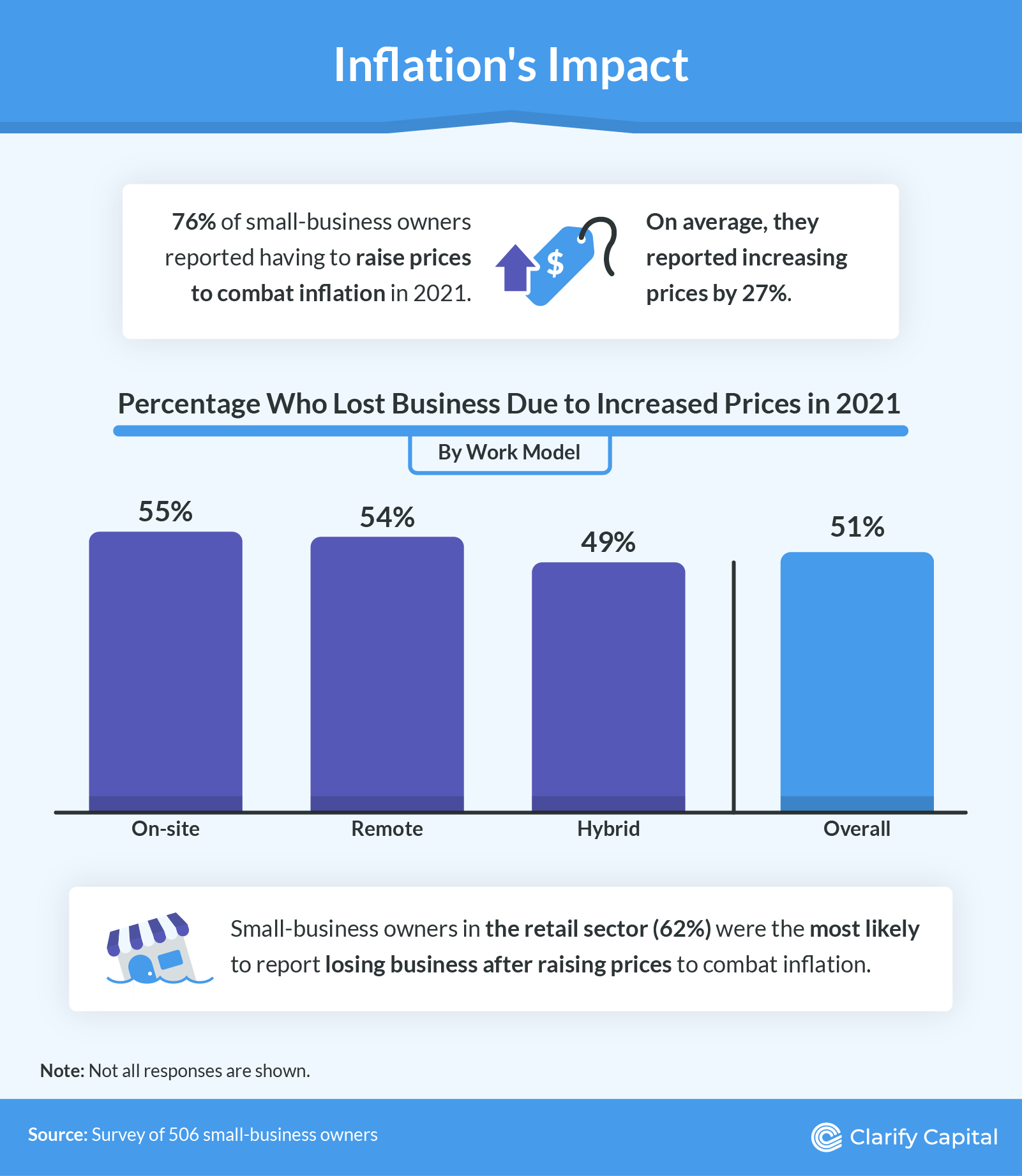
Small businesses have little choice but to raise their prices when faced with inflation. This can be tough on owners who pride themselves on fair prices but are forced to pay higher rates themselves, sending a ripple of cost all the way down to the consumer.
More than three-quarters of the small-business owners we surveyed had to raise their prices to offset inflation costs in 2021. Hybrid workplaces were the least affected by this issue, although 49% still reported losing business as a result. Meanwhile, 55% of on-site business owners said the same, as did 54% of those who had adopted a remote work model. Nevertheless, 44% of all respondents said they would have to continue raising prices to mitigate inflation.
Waiting on Product
In a world where consumers expect next-day free shipping on everything from socks to vehicles, disruptions to the supply chain can really affect a small business's ability to compete.
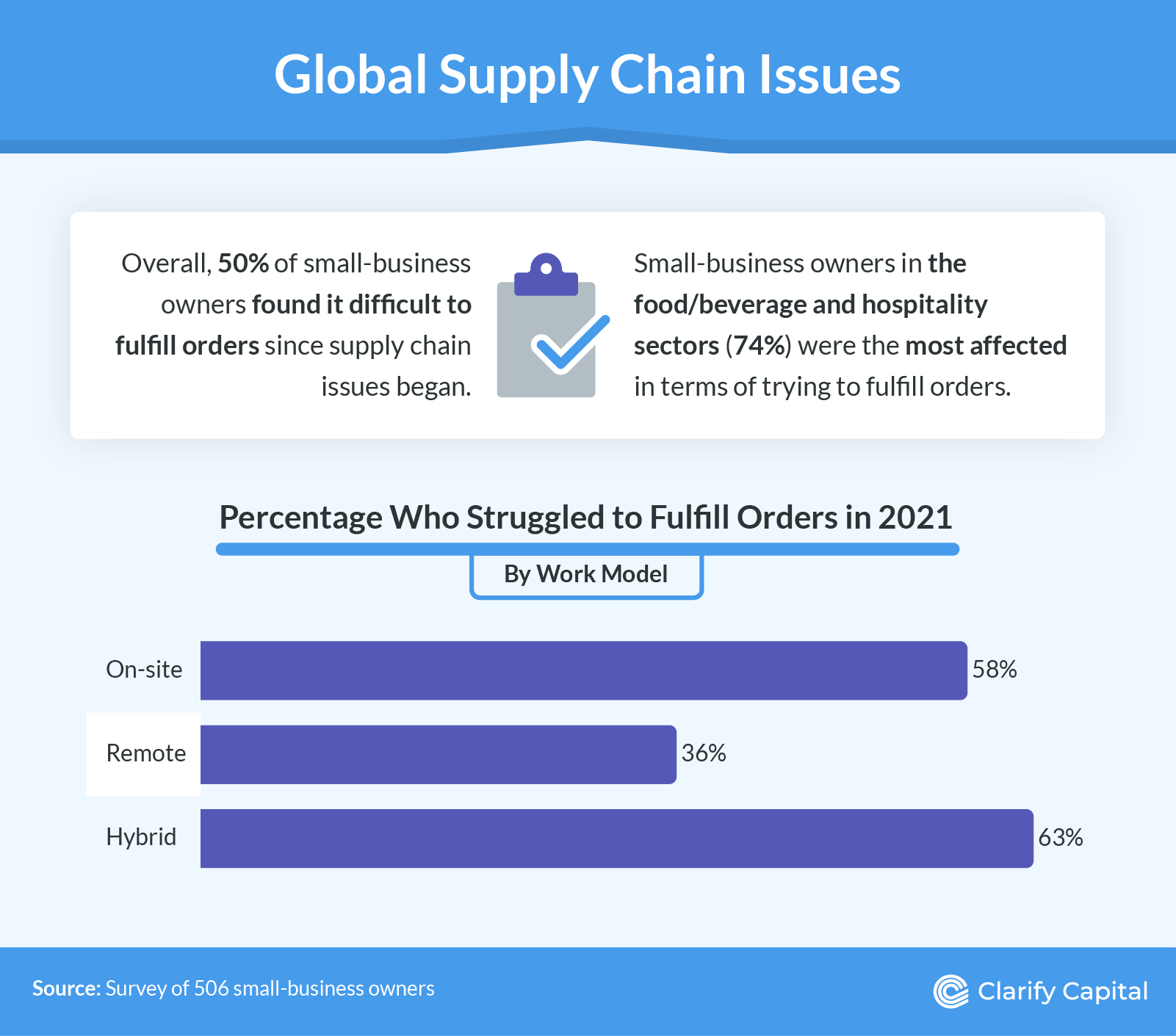
If businesses are unable to fulfill orders in a timely manner—or even at all—they run the risk of not only frustrating loyal customers but losing them completely. Small businesses are disproportionately affected by supply chain issues, with fewer resources to manage these challenges than larger companies. This is especially true for industries that operate at least partially on-site, such as those in shipping and logistics. Our results showed that small businesses in the food/beverage and hospitality industries struggled the most to fulfill orders as a result of supply disruption—a notorious example of this being the chicken wing shortage of 2021.
Perhaps surprisingly, when broken down by work model, it was hybrid business owners who were most likely to report struggling to fulfill orders at 63%, compared to 58% of on-site owners and just 36% of remote owners. Some small-business owners were also forced to search for new vendors with better prices, a challenge that 44% of our respondents said they found difficult.
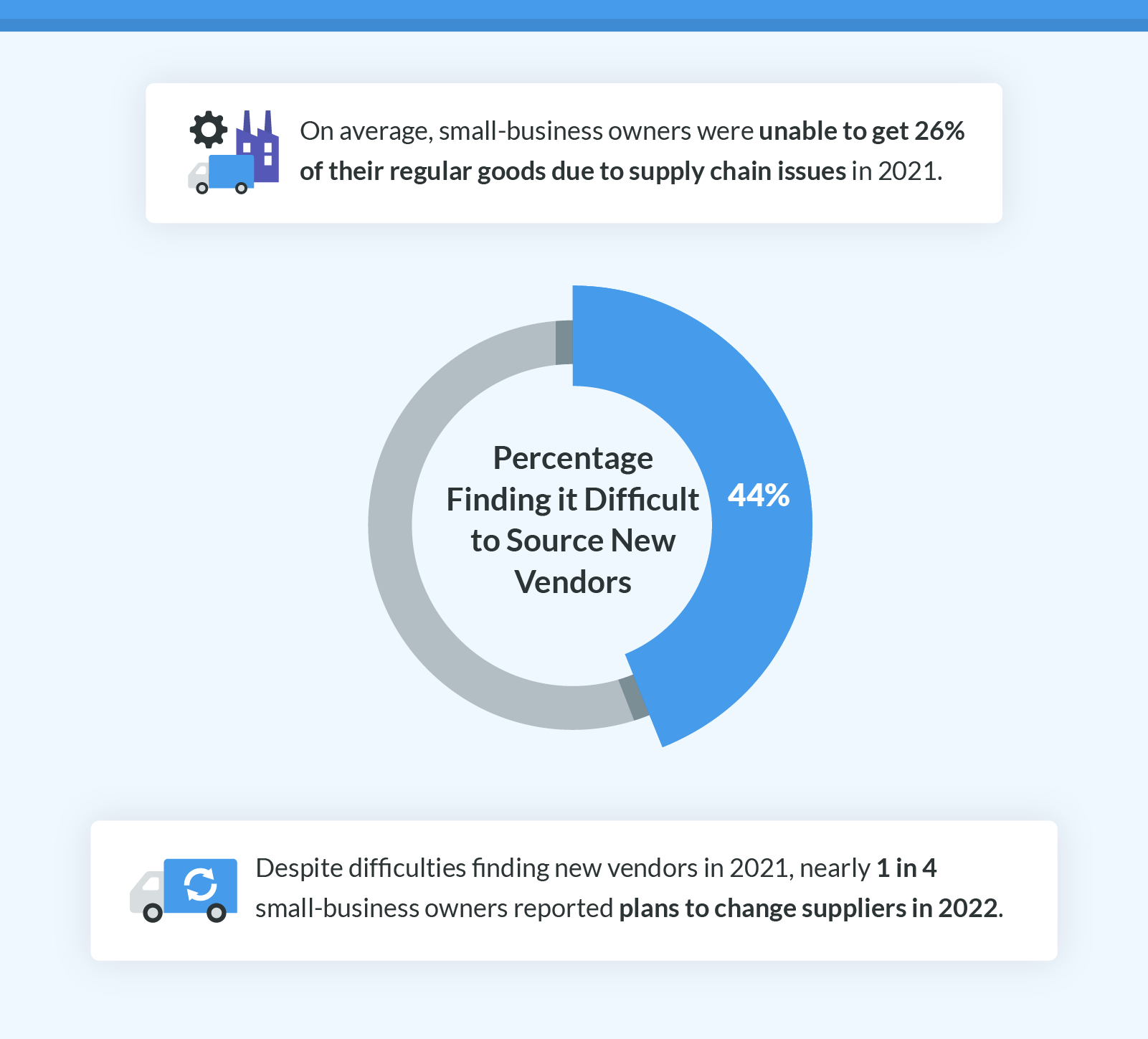
Running Shorthanded, Indefinitely
Handwritten signs apologizing for slow service due to staffing issues are starting to become as ubiquitous on the storefronts of small businesses as their operating hours. Many businesses around the nation are struggling to hire sufficient workers to fulfill their needs and are having to get creative to overcome the problem.
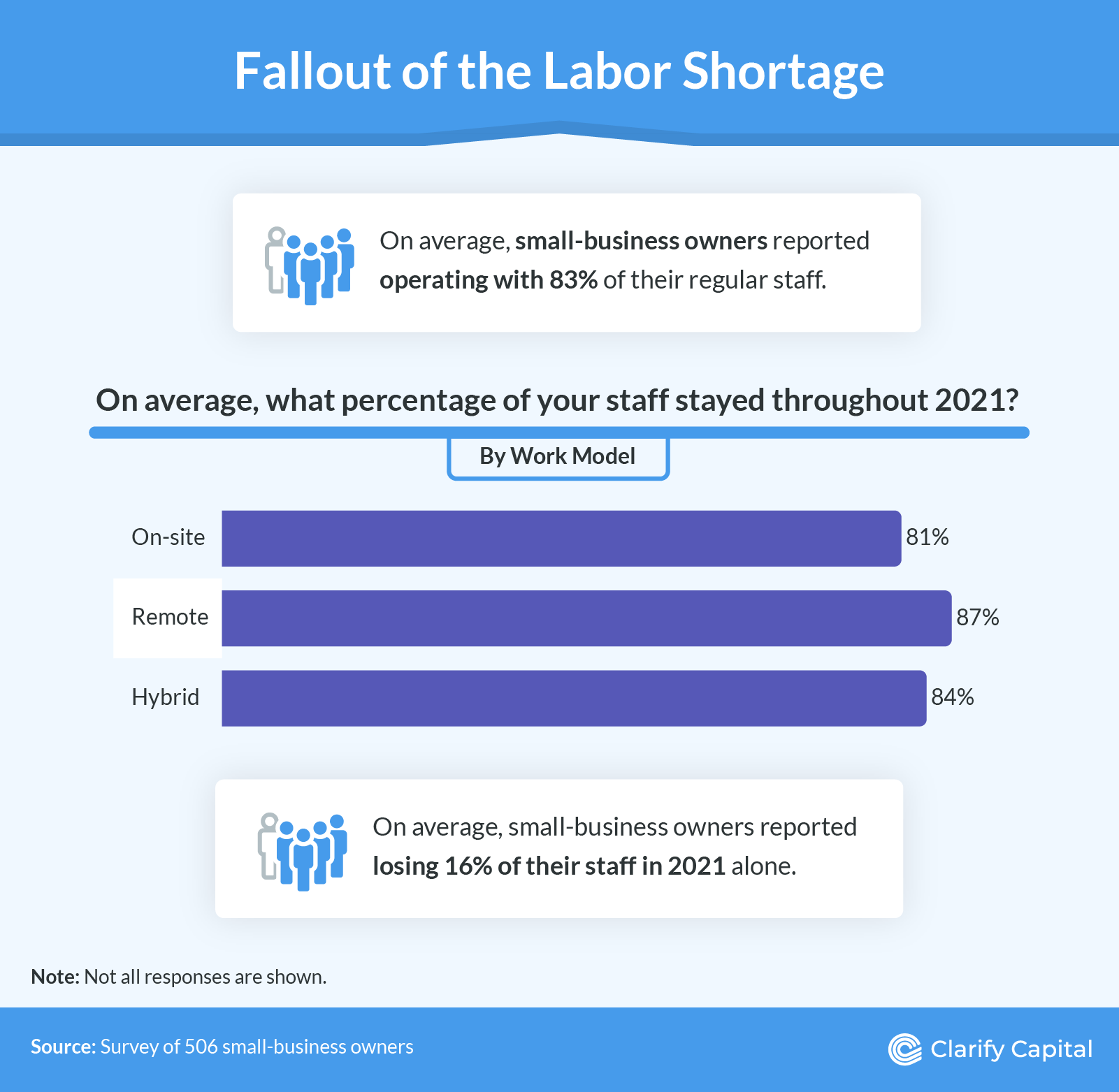
On average, respondents reported operating with 83% of their regular staff. Owners of remote workplaces reported the highest levels of employee retention throughout the past year at 87%, compared to 84% for hybrid businesses, and just 81% for on-site businesses. The upside is that many businesses have been able to keep their doors open despite losing a significant percentage of their workforce, and even on-site industries, such as retail outlets and restaurants, reported large bounce backs from the COVID-19 pandemic.
Looking for the Bright Side
The outlook for 2022 may seem grim considering the issues small-business owners continue to face; however, the sector is still seeing some growth. The number of small-business applications rose from 4.4 million in 2020 to 5.4 million in 2021, according to the U.S. Census Bureau.
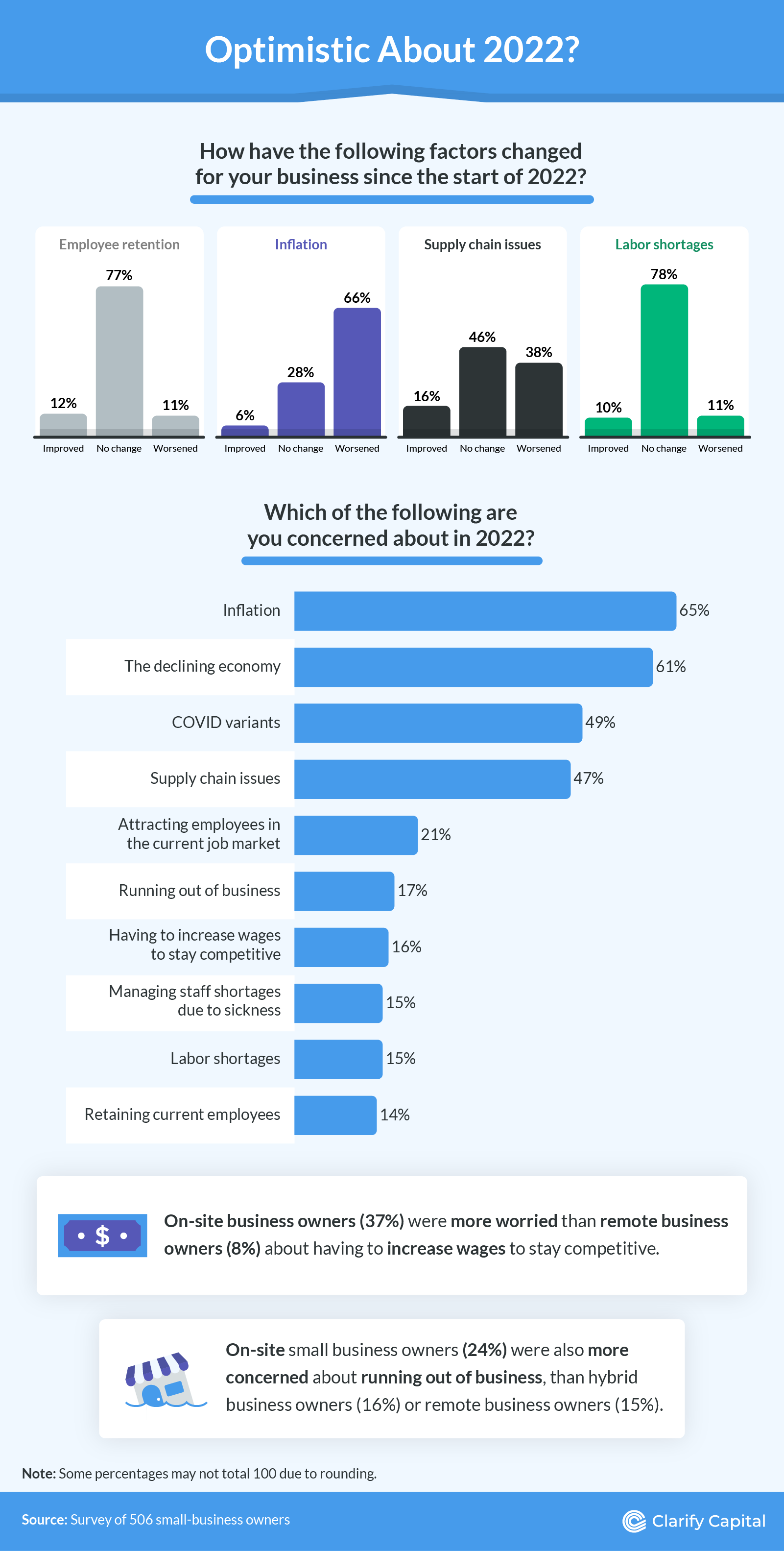
Despite this growth, the small-business owners we surveyed were fairly split when it came to their outlook for the new year. While more than three-quarters of small-business owners didn't foresee changes in the labor shortage situation, 66% of respondents felt that inflation would get worse, and 38% felt that supply chain issues would worsen as well.
Overall, inflation and the declining economy were the biggest worries for small-business owners in 2022. More specifically, the economy was the biggest reported concern for remote small-business owners, while inflation was the top concern for hybrid and on-site owners. Interestingly, hybrid and remote business owners reported much less concern over having to increase wages to stay competitive, at 14% and 8%, respectively. This was compared to 37% for on-site business owners.

Challenges Still on the Horizon
Small-business owners all around the country have faced a multitude of recent changes, in everything from how they handle sanitation all the way to strategies for retaining their workforce. Survey respondents reported facing many challenges on a day-to-day basis, including trying to find enough employees to cover each shift and figuring out where their next supply order was coming from.
Among them, on-site business owners have had, for the most part, a tougher time in the last few years. Remote and hybrid workplaces are becoming more attractive to job seekers than ever before. These challenges, however, have led small-business owners to be more innovative and discover new potential in their businesses. If there is a silver lining to being a small-business owner in a post-pandemic world, perhaps exceeding one's own expectations is it.
If your small business is looking to innovate and take steps to grow in the coming years, Clarify Capital is the partner to help you do just that. They can provide you with the resources you need to overcome your struggles and emerge stronger than before. Visit www.clarifycapital.com for more details.
Methodology and Limitations
We surveyed 506 small-business owners about their reaction to labor shortages, global supply chain problems, and inflation. Among them, 44% were men, 55% were women, and 1% identified as nonbinary.
For short, open-ended questions, outliers were removed. To help ensure that all respondents took our survey seriously, they were required to identify and correctly answer an attention-check question.
Survey data have certain limitations related to self-reporting. These limitations include telescoping, exaggeration, and selective memory. We didn't weight our data or statistically test our hypothesis. Our margin of error was +/- 4% with a 95% confidence interval.
Fair Use Statement
If you benefited from reading our survey on small-business struggles in the current economic climate, feel free to share for any noncommercial purpose. When doing so, please be sure to link back to the original article so that our contributors can receive credit for their work.
